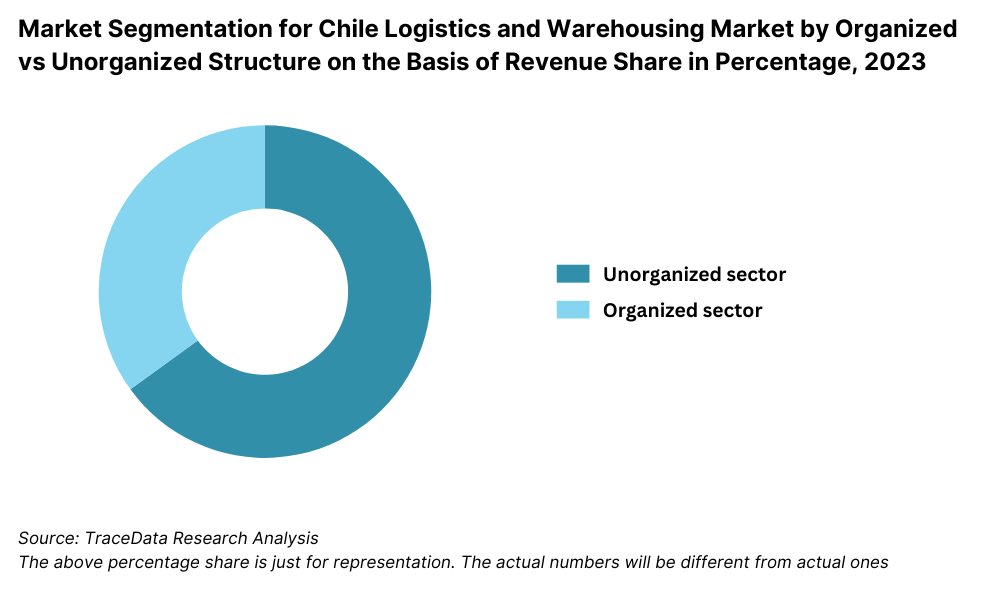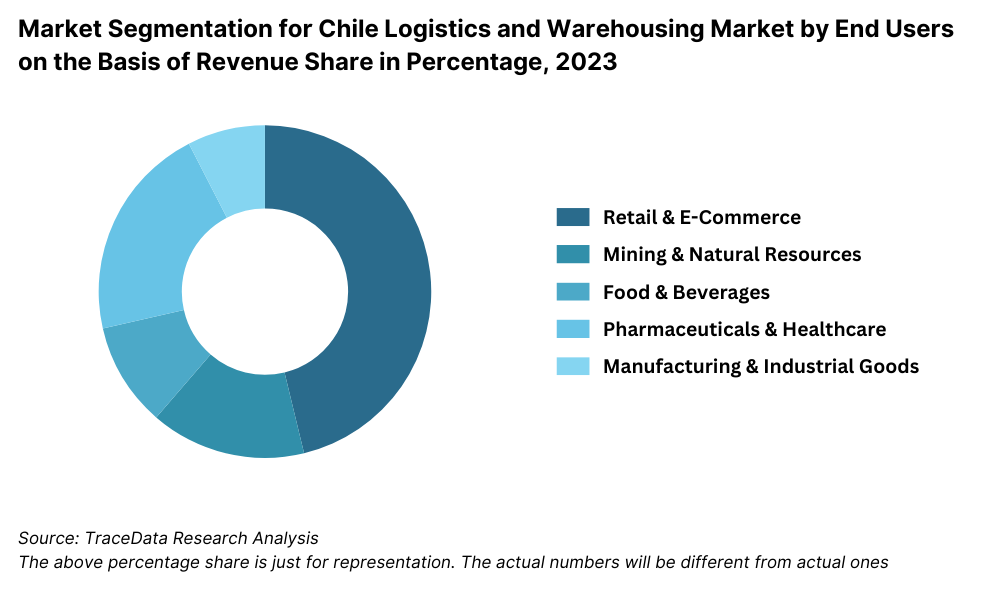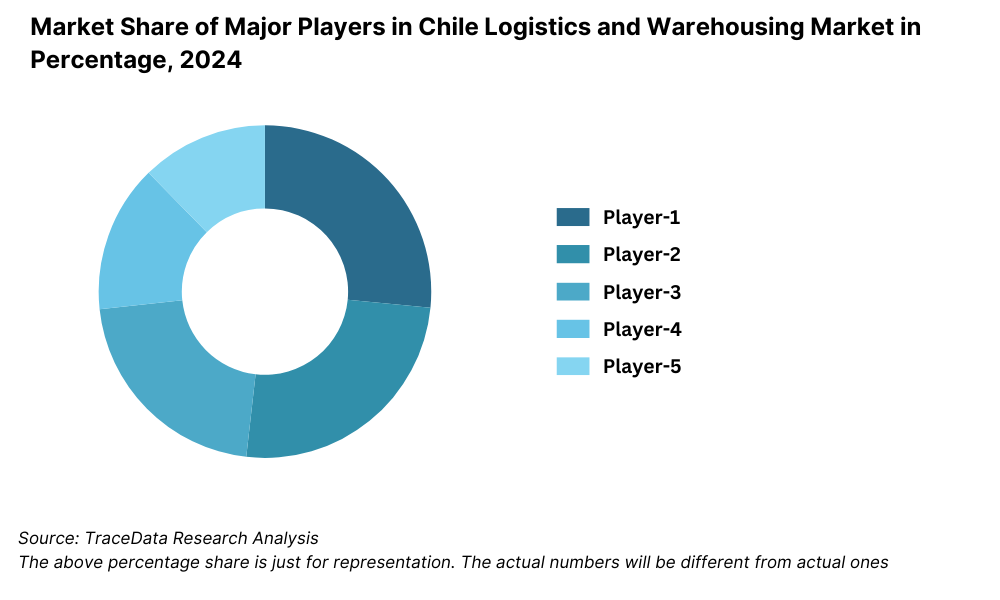Chile Logistics and Warehousing Market Outlook to 2029
By Service Segments (Freight Forwarding, Warehousing, and Courier & Parcel), By End Users, By Domestic vs International Shipments, By Regions
- Product Code: TDR0270
- Region: Central and South America
- Published on: September 2025
- Total Pages: 110
Introducing the World's FirstPay-Per-Section Market Reports
Why pay for the full report when you need just a part?
Start Building Your Report
Scroll down to see available sections
Report Summary
The report titled “Chile Logistics and Warehousing Market Outlook to 2029 – By Service Segments (Freight Forwarding, Warehousing, and Courier & Parcel), By End Users, By Domestic vs International Shipments, By Regions.” provides a comprehensive analysis of the logistics and warehousing industry in Chile. The report covers the industry overview and genesis, overall market size in terms of revenue, market segmentation, key trends and developments, regulatory framework, customer demand patterns, issues and challenges, and a comparative landscape including competition scenario, cross comparisons, opportunities and bottlenecks, and company profiling of major logistics players. The report concludes with future market projections based on service segments, regions, demand-side trends, and success case studies highlighting major growth drivers and limitations.
Chile Logistics and Warehousing Market Overview and Size
The Chilean logistics and warehousing market was valued at USD 25 billion in 2023, driven by expanding international trade, infrastructure development, and the rapid growth of e-commerce. Key players in the market include Blue Express, CorreosChile, DHL, Kuehne + Nagel, Agunsa, and Andes Logistics, who are recognized for their strong distribution networks, warehousing capabilities, and customized logistics solutions across various verticals.
In 2023, Blue Express expanded its last-mile delivery fleet by over 20% to cater to surging e-commerce volumes. Additionally, Chile’s strategic ports like Valparaíso and San Antonio have positioned the country as a major logistics hub for the Southern Cone, enhancing its connectivity with global trade routes.
%2C%202019-2024.png)
What Factors are Leading to the Growth of Chile Logistics and Warehousing Market:
Trade Liberalization and Export Growth: Chile’s numerous Free Trade Agreements (FTAs) and its export-oriented economy—particularly in copper, fresh fruits, seafood, and wine—drive demand for international logistics services. In 2023, exports accounted for nearly 30% of the country’s GDP, necessitating efficient freight forwarding and port logistics.
Booming E-Commerce Sector: The rise in online retailing, with a 16% CAGR in e-commerce transactions between 2020 and 2023, has created substantial demand for warehousing and last-mile delivery solutions. Logistics firms are now investing in smart warehousing and automation technologies to improve delivery timelines and inventory management.
Infrastructure Investment: Government-backed projects such as road expansions, rail connectivity enhancements, and port modernization (e.g., Puerto San Antonio Mega Port Project) are improving supply chain efficiency. These developments are enabling faster transit and reducing logistics costs for businesses operating across urban and remote regions.
Which Industry Challenges Have Impacted the Growth for Chile Logistics and Warehousing Market
Infrastructure Bottlenecks: Despite recent investments, Chile still faces challenges related to road congestion, limited intermodal connectivity, and aging port facilities. According to a 2023 industry survey, over 35% of logistics providers reported delays due to road congestion in metropolitan areas like Santiago and Valparaíso. These inefficiencies increase transit times and operational costs, particularly for time-sensitive deliveries.
High Logistics Costs: Chile has one of the highest logistics costs in Latin America, amounting to nearly 14% of GDP in 2023. This high cost structure stems from fragmented supply chains, low warehouse automation levels, and high fuel prices. Small and medium-sized enterprises (SMEs), in particular, find it challenging to compete due to disproportionately higher last-mile delivery expenses.
Skilled Labor Shortage: A growing shortage of skilled labor—especially in warehouse management, cold chain logistics, and digital tracking systems—is affecting operational efficiency. In a 2023 industry report, nearly 42% of logistics companies cited workforce scarcity as a major constraint, impacting order accuracy, inventory handling, and customer service standards.
What are the Regulations and Initiatives which have Governed the Market
National Logistics Policy (PNLog): The Chilean government introduced the National Logistics Policy to strengthen public-private collaboration, improve infrastructure planning, and promote digitization across the logistics value chain. Under PNLog, over USD 1.2 billion was earmarked for logistics corridor development and port enhancement projects between 2021 and 2024.
Customs Modernization Law: In 2022, Chile enacted reforms to streamline customs procedures and reduce documentation time for imports and exports. As a result, average clearance time dropped by 15% in 2023, significantly benefiting cross-border freight forwarding and reducing demurrage charges at ports.
Green Logistics Initiatives: To align with Chile’s sustainability goals, the Ministry of Transport launched a Green Logistics Roadmap encouraging low-emission transport and eco-friendly warehousing practices. In 2023, nearly 9% of last-mile delivery fleets in Santiago were converted to electric vehicles, supported by government subsidies and tax incentives.
Chile Logistics and Warehousing Market Segmentation
By Market Structure: The Chilean logistics sector is dominated by unorganized and local logistics providers, particularly in rural and regional areas where access to large integrated players is limited. These players offer customized solutions and personal relationships with clients, which increases local trust. However, organized third-party logistics (3PL) and multinational providers are rapidly gaining share in urban areas such as Santiago, Valparaíso, and Antofagasta, driven by demand for efficiency, technology integration, and scalable operations. Companies like DHL, Kuehne + Nagel, and Blue Express are expanding rapidly due to their tech-driven solutions and reliable service quality.

By End Users: The retail and e-commerce sectors are the largest consumers of logistics services in Chile, especially for last-mile delivery and inventory management. The mining industry, being a major economic pillar of Chile, contributes significantly to long-haul freight and bulk storage demand. Additionally, the food and beverage sector—including exports of wine, seafood, and fresh produce—requires cold chain and time-sensitive logistics solutions, creating a strong demand for temperature-controlled warehousing.

By Region: Santiago Metropolitan Region leads the market due to its high population density, central location, and superior infrastructure. Valparaíso and Biobío regions follow, given their proximity to ports and industrial zones. Northern regions such as Antofagasta are vital for mining logistics, while southern regions like Los Lagos and Araucanía are key hubs for agribusiness and cold chain operations.
Competitive Landscape in Chile Logistics and Warehousing Market
The Chile logistics and warehousing market is moderately consolidated, with a mix of international logistics giants and strong domestic players. Global companies like DHL and Kuehne + Nagel compete with regional leaders such as Blue Express, CorreosChile, and Agunsa. The rapid growth of e-commerce and increasing demand for tech-enabled logistics have also spurred the emergence of innovative startups and last-mile service providers.
Company | Establishment Year | Headquarters |
Blue Express | 2001 | Santiago, Chile |
CorreosChile | 1747 (Modernized 1981) | Santiago, Chile |
DHL Chile | 1979 (Global) | Santiago, Chile |
Kuehne + Nagel | 1890 (Global) | Santiago, Chile |
Agunsa | 1960 | Santiago, Chile |
Andes Logistics | 2007 | Santiago, Chile |
Some of the recent competitor trends and key information about competitors include:
Blue Express: One of the largest last-mile delivery providers in Chile, Blue Express expanded its delivery fleet by 20% in 2023 to meet surging e-commerce demand. The company also invested in route optimization technologies and opened two new distribution centers in the Valparaíso and Biobío regions.
CorreosChile: As the national postal and logistics company, CorreosChile handled over 90 million parcels in 2023. The firm has upgraded its tracking systems and launched express delivery services, targeting the growing demand from SMEs and online retailers.
DHL Chile: Leveraging its global network, DHL Chile saw a 12% increase in cross-border freight volumes in 2023. The company continues to invest in cold chain logistics, supporting the export of Chilean seafood and fruit to international markets.
Kuehne + Nagel: This global freight forwarding leader reported a 15% increase in warehousing demand in Chile, driven by its expansion into temperature-controlled storage and integrated supply chain services for the mining and agriculture sectors.
Agunsa: With expertise in port operations and integrated logistics, Agunsa expanded its multimodal services across the Pacific coast. In 2023, the company partnered with various shipping lines to improve container handling efficiency at Puerto San Antonio.
Andes Logistics: Known for its flexibility and strong regional presence, Andes Logistics focused on digital freight brokerage and real-time tracking solutions. The firm experienced 18% revenue growth in 2023, particularly in the retail and pharma sectors.

What Lies Ahead for Chile Logistics and Warehousing Market?
The Chile logistics and warehousing market is projected to grow steadily through 2029, registering a moderate yet sustainable CAGR over the forecast period. Growth will be underpinned by the expansion of e-commerce, increasing infrastructure investments, and Chile’s strategic position as a trade gateway for Latin America.
Expansion of E-commerce Logistics: As online retail penetration deepens across Chile, logistics companies are expected to expand last-mile delivery networks, invest in micro-fulfillment centers, and deploy automated solutions to handle high order volumes. The demand for rapid delivery and seamless returns will shape the future of urban logistics in cities like Santiago and Concepción.
Rise of Cold Chain Logistics: With Chile’s strong position in fresh food exports—including seafood, fruits, and dairy—the cold chain segment is poised for growth. New investments in temperature-controlled warehousing and refrigerated transport will be critical in meeting international quality standards and minimizing spoilage during transit.
Integration of Digital Supply Chain Technologies: The adoption of technologies such as IoT, AI, and blockchain for inventory tracking, demand forecasting, and route optimization will become mainstream. By 2029, logistics companies that invest in end-to-end digital visibility are expected to outperform their competitors in efficiency, reliability, and customer satisfaction.
Growth in Sustainable Logistics: Environmental concerns and regulatory pressure are expected to push companies toward green logistics. This includes the adoption of electric delivery fleets, energy-efficient warehouses, and carbon offset initiatives. The Chilean government’s sustainability roadmap will further support these shifts through policy incentives and public-private collaboration.
%2C%202024-2030.png)
Chile Logistics and Warehousing Market Segmentation
- By Market Structure:
o Freight Forwarding Companies
o Courier & Parcel Delivery Services
o Third-Party Logistics (3PL) Providers
o In-house Logistics Operators
o Organized Sector
o Unorganized Sector
o Cold Chain Logistics Providers - By End Users:
o E-commerce & Retail
o Food & Beverage
o Mining & Natural Resources
o Pharmaceuticals & Healthcare
o Automotive
o Construction Materials
o Agriculture & Fresh Produce - By Shipment Type:
o Domestic
o International - By Transportation Mode:
o Road Freight
o Rail Freight
o Air Freight
o Maritime Shipping - By Storage Type:
o General Warehousing
o Cold Storage Warehousing
o Bonded Warehousing
o Automated Warehousing - By Region:
o Santiago Metropolitan Region
o Valparaíso Region
o Biobío Region
o Antofagasta Region
o Araucanía & Southern Chile
o Central Chile
Players Mentioned in the Report
- Blue Express
- CorreosChile
- DHL Chile
- Kuehne + Nagel Chile
- Agunsa
- Andes Logistics
- FedEx Express Chile
- Transvip
- Ransa Chile
- DB Schenker Chile
Key Target Audience
- Third-Party Logistics (3PL) Companies
- Warehousing and Storage Operators
- E-commerce and Retail Platforms
- Cold Chain Logistics Providers
- Government and Transport Ministries
- Port and Customs Authorities
- Investors and Infrastructure Funds
- Freight Forwarding Companies
- Industry Associations and Chambers of Commerce
Time Period
- Historical Period: 2018–2023
- Base Year: 2024
- Forecast Period: 2024–2029
Report Coverage
Choose individual sections to purchase. Mix and match as you like.
- -
- -
- $100
4.1. Value Chain Process-Role of Entities, Stakeholders, and Challenges They Face
4.2. Revenue Streams for Chile Logistics and Warehousing Market
4.3. Business Model Canvas for Chile Logistics and Warehousing Market
4.4. Shipment Decision-Making Process
4.5. Warehousing and Distribution Decision-Making Process
$2505.1. Import-Export Trade Volume of Chile, 2018-2024
5.2. Domestic vs International Freight Volume in Chile, 2018-2024
5.3. Logistics Spend as % of GDP in Chile, 2024
5.4. Number of Logistics Companies in Chile by Region
$150- $100
- $200
8.1. Revenues, 2018-2024
8.2. Volume Handled (Tons), 2018-2024
$3009.1. By Market Structure (Organized and Unorganized Sector), 2023-2024P
9.2. By End User Industries (Retail, Mining, Agriculture, etc.), 2023-2024P
9.3. By Region (Santiago, ValparaÃso, BiobÃo, etc.), 2023-2024P
9.4. By Mode of Transport (Road, Rail, Air, Sea), 2023-2024P
9.5. By Shipment Type (Domestic vs International), 2023-2024P
9.6. By Storage Type (General, Bonded, Cold Chain, Automated), 2023-2024P
$40010.1. Client Landscape and Procurement Behavior
10.2. Logistics Journey and Decision-Making Drivers
10.3. Need, Desire, and Pain Point Analysis
10.4. Gap Analysis Framework
$50011.1. Trends and Developments in Chile Logistics and Warehousing Market
11.2. Growth Drivers for Chile Logistics and Warehousing Market
11.3. SWOT Analysis for Chile Logistics and Warehousing Market
11.4. Issues and Challenges in the Chile Logistics and Warehousing Market
11.5. Government Policies and Regulations Governing the Market
$20012.1. Market Size and Future Potential for E-commerce Logistics, 2018-2029
12.2. Business Models and Revenue Streams
12.3. Cross Comparison of Leading E-commerce Logistics Companies: Services, Network, Revenue, Infrastructure, and Client Sectors
$50013.1. Infrastructure Investment Trends, 2018-2029
13.2. Public vs Private Investment Split
13.3. Logistics Startup Ecosystem and VC/PE Involvement
13.4. Average Cost of Warehousing and Freight Financing
13.5. Financial Viability of Cold Chain and Smart Warehousing Projects
$250- $250
- $150
16.1. Benchmark of Key Competitors Including Overview, Capabilities, Business Model, Strengths, Weaknesses, Service Verticals, Infrastructure, and Value-Added Services
16.2. Strength and Weakness Assessment
16.3. Operating Model Analysis Framework
16.4. Gartner Magic Quadrant Positioning
16.5. Bowmans Strategic Clock for Competitive Advantage
$75017.1. Revenues, 2025-2029
17.2. Volume Handled (Tons), 2025-2029
$30018.1. By Market Structure (Organized and Unorganized Sector), 2025-2029
18.2. By End User Industries (Retail, Mining, Agriculture, etc.), 2025-2029
18.3. By Region (Santiago, ValparaÃso, BiobÃo, etc.), 2025-2029
18.4. By Mode of Transport (Road, Rail, Air, Sea), 2025-2029
18.5. By Shipment Type (Domestic vs International), 2025-2029
18.6. By Storage Type (General, Bonded, Cold Chain, Automated), 2025-2029
18.7. Recommendations
18.8. Opportunity Analysis
$400
Research Methodology
Step 1: Ecosystem Creation
Map the ecosystem and identify all the demand side and supply side entities for the Chile Logistics and Warehousing Market. Basis this ecosystem, we will shortlist leading 5–6 logistics players in the country based upon their financial information, service capacity, infrastructure network, and client base.
Sourcing is made through industry articles, multiple secondary, and proprietary databases to perform desk research around the market to collate industry-level information.
Step 2: Desk Research
Subsequently, we engage in an exhaustive desk research process by referencing diverse secondary and proprietary databases. This approach enables us to conduct a thorough analysis of the market, aggregating industry-level insights. We delve into aspects like logistics revenue, warehousing capacity, transportation modes, key infrastructure developments, and regional split of services.
We supplement this with detailed examinations of company-level data, relying on sources like press releases, annual reports, logistics industry white papers, and financial statements. This process aims to construct a foundational understanding of both the market and the entities operating within it.
Step 3: Primary Research
We initiate a series of in-depth interviews with C-level executives and other stakeholders representing various Chilean logistics companies, warehousing operators, e-commerce retailers, and key end-users from sectors like mining, food, and pharmaceuticals. This interview process serves a multi-faceted purpose: to validate market hypotheses, authenticate statistical data, and extract valuable operational and financial insights from these industry representatives.
Bottom to top approach is undertaken to evaluate revenue contribution and warehousing volumes by each operator, thereby aggregating to the overall market.
As part of our validation strategy, our team executes disguised interviews wherein we approach each company under the guise of potential customers. This approach enables us to validate the operational and financial information shared by company executives, corroborating this data against what is available in secondary databases. These interactions also provide us with a comprehensive understanding of logistics processes, fleet strength, pricing models, infrastructure utilization, and client servicing mechanisms.
Step 4: Sanity Check
- Bottom to top and top to bottom analysis along with market size modeling exercises is undertaken to assess sanity check process. Data triangulation and logical reconciliation of both primary and secondary inputs are used to finalize the market sizing and segmentation outputs.
FAQs
1. What is the potential for the Chile Logistics and Warehousing Market?
The Chile logistics and warehousing market holds strong growth potential, reaching a valuation of USD 25 billion in 2023. This growth is supported by factors such as Chile’s strategic geographic location, expansion in international trade, booming e-commerce, and ongoing infrastructure development. The market is poised for further expansion as digitalization and cold chain capabilities become more widespread.
2. Who are the Key Players in the Chile Logistics and Warehousing Market?
Key players in the Chilean logistics and warehousing market include Blue Express, CorreosChile, DHL Chile, Kuehne + Nagel, Agunsa, and Andes Logistics. These companies dominate due to their extensive delivery networks, warehousing capabilities, and strong relationships with both domestic and international clients.
3. What are the Growth Drivers for the Chile Logistics and Warehousing Market?
Major growth drivers include the rapid expansion of the e-commerce sector, increasing exports in mining and agriculture, adoption of smart supply chain technologies, and government investments in logistics infrastructure. Policies such as the National Logistics Policy (PNLog) and customs reforms are also enabling faster and more efficient trade operations.
4. What are the Challenges in the Chile Logistics and Warehousing Market?
Key challenges include high logistics costs, infrastructure bottlenecks, and a shortage of skilled labor in specialized logistics areas such as cold chain and digital warehousing. Additionally, regulatory compliance, especially for cross-border shipments and environmental standards, remains a constraint for smaller logistics players.